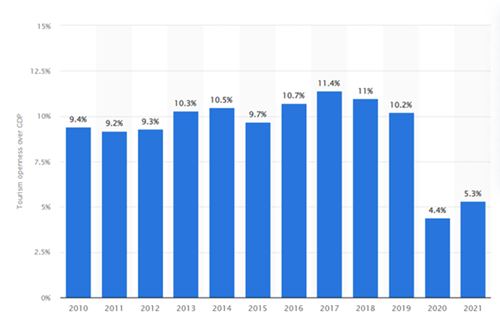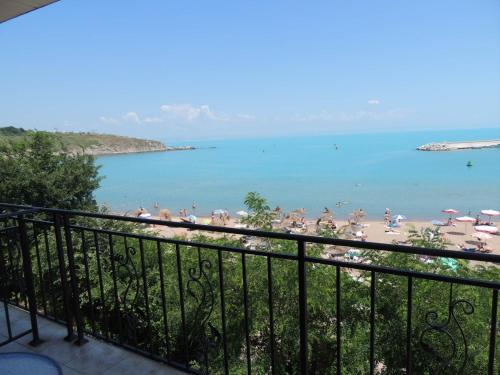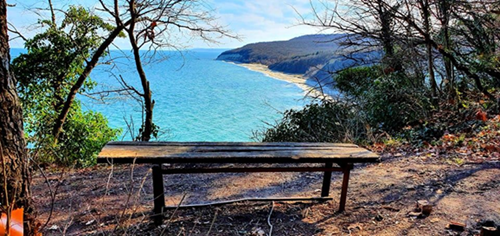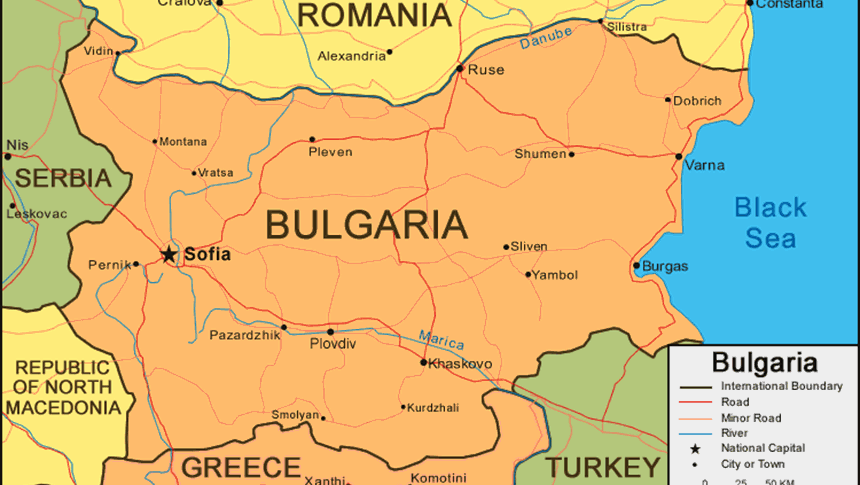Introduction – structure of HRI in Bulgaria:
Bulgaria is located, as seen above in Eastern Europe, it has a territorial size of 111 910 sq. km. similar to the other 10 small Balkan countries, whose land was divided by two world wars and their victors. Culturally, the 7 million people population of Bulgaria has been governed and influenced at different points in the past by The Ottoman Empire outright, and later using puppet governments of the leaders of the Soviet Union. (Geography Web, 2021) This part of the Balkan peninsula boasts mountains as high as 5000 meters, with complex river systems flowing down from them, as well as the north border of Bulgaria with Romania, which is entirely made up of the Danube River, the largest in Europe. This river ends in the main topic of discussion geographically of this blog – The Black Sea. (Geography Web, 2021)
Because of the Soviet influence, in the past, most citizens of Bulgaria could travel 2 weeks to a designated Black Sea or Balkan destination which would host tourists from only Bulgaria. This means for the modern Bulgaria HRI that facilities are left over from the 80s and earlier, as no investment has been made to improve these, after the fall of communism in the country around the 1990s. It was a nationalised industry, and private franchises typically do not invest in the Bulgarian market due to this seasonality created ever since people could go on holiday only when planned by the Government. It can be seen in the trends today, such as the highest influx of tourists being in the summer, beginning with May until October, as the new tourism facilities are privately owned hotels at these seaside foreign chain hotels. Mountain regions are protected national parks in the modern era, hence little to no funding is provided to renovate existing hotels and restaurant facilities in those regions, as there is no prospect of probable expansion of these, after the renovation. (Taneva, 2019)
The country’s geographic placement is as a bridge between the Asian Continent and the European Continent, which politically is great for its developing economy. As of 2021 figures of the Bulgarian GDP indicate sums of over 80 billion dollars. The main contributing factor to the economy is undoubtedly tourism and HRI (hospitality and restaurant industry) being responsible for over 5 percent of the total GDP. (Taneva, 2019) Neighbouring countries’ citizens such as Greece and Romania, with higher GDPs in comparison to Bulgaria, find it cheaper to go to the Black Sea in the summer and Balkan Mountains for skying in the winter than to do that in their own countries. Hence, this attracts foreigners from overseas as well. (Taneva, 2019)
Below is a graph of tourism and HRI contribution to the Bulgarian GDP over the last decade. It is safe to assume that numbers in 2020 and 2021 are low due to COVID pandemic, as this was a global trend in these industries. (Taneva, 2019)

(Statista Research , 2022) - Tourism contribution to Bulgarian GDP
Hospitality and Restaurant Services on Offer
Geographically Bulgaria is high in the potential development of these industries, as it has natural resources on its territory, like The Black Sea to the East and the Mountains for winter activities in the West, all within a 4-hour drive of each other. The country’s natural resource’s location allows for easy access to things such as the only naturally occurring hot water gazer in the Balkans, for Spa treatments, near a densely populated area that includes amenities for modern tourists. This combination of modern infrastructure with natural resources and the openness of the Bulgarian culture to that of its neighbours and foreigners is the perfect recipe for annual growth of tourists. (Taneva, 2019)
Bulgaria’s HRI caters to over 7 billion tourists annually, of which 57 percent are from countries within the European Union, the largest being nearly 1 and a half million Romanians, followed by just over 1 million Greeks. The third largest number of tourists comes from the UK and Germany, with nearly 1 million annually. (Guide to Europe, 2021) This has had an impact on cuisine variety, for example, “Musaka”, a traditional bake of minced meat, potatoes, and baked yoghurt crust has its roots in Greek culture and cuisine as well as Romania’s “Mamaliga”, corn stew, in Bulgaria is called “Kachamak” and is made with similar ingredients. (Taneva, 2019) This opened the industry to foreign franchises such as “Happy” Restaurants. A Greek brand that operates across the Balkans, serving traditional cuisines of all these regions. Since entering the Bulgarian Market it has opened more new restaurants than McDonald’s and KFC combined, due to offering the abovementioned traditional meals, along with foreign-influenced cuisines such as sushi or burgers. Mostly, artisan and home-cooked meals are preferred by the Bulgarian population, which has had to deal with scarcity of food on multiple occasions, like the Balkan Wars of 1912 and aforementioned World Wars and Soviet influence. Due to recent tensions with the special military operation of Putin’s Russia, an influx of Ukrainians has explored the option of moving to Bulgaria’s Black Sea, which further increases the number of annual tourists. (Statista Research, 2022) The tourism season is open all year round, finding its peak in and around May to October.
HRI at The Black Sea in Bulgaria
The Bulgarian Government would like to change this seasonality-based peak, as most of the 7 billion tourists are mainly headed to the Black Sea resorts in summer and do not find the winter months or destinations desirable, regardless of the low prices. “To eliminate this fluctuation, the Bulgarian Tourism and Hospitality Cabinet is trying to publicize the country as a year-round tourist destination with a focus on cultural/historic tourist routes and mountain tourism, as well as alternative tourism. Another policy is to relax visa requirements for tourists from non-EU countries.” (Boshnakova & Todorov, 2019) Because not much is known about Bulgarian traditions, history, and culture, to foreign tourists, most global hotel brands have been reserved when looking to enter the Bulgarian market. Not only due to its seasonality, but also because of how much resources global hospitality and restaurant franchise brands must spend to research their cost and potential for breaking even, as well as to set viable prices for staying at a hotel or eating in a franchise restaurant. Not much is known about the culture outside of Bulgaria, because of the lack of investment by the government in foreign affairs. Most tourists come to Bulgaria, as they view it as a cheap destination, with acceptable food and service standards, overlooking heritage and simply focusing on cost. Like Hilton or Marriot hotels, they prefer to enter the Bulgarian HRI through purchasing established local franchises and simply renovating them, again due to the cost of research and development it would take to such a niche market. Nobody seems to be willing to invest in the development of this self-sustaining market, backed by the beautiful nature of the Bulgarian seaside and its main two cities Burgas and Varna. (Taneva, 2019)

Personal Picture – Varna sign in Central Park
Burgas and Varna are The Black Sea’s metropoleis, however focus on other largely populated areas can be expected, following trends of development. Sofia, the capital city, is the largest by land mass and population, followed by Plovidv in population, and Burgas and Varna by land mass. Expansion to these regions will be expected of the HRI in Bulgaria, as these areas see the most foreign investment. For example, hostels in these areas are much more expensive, but rare to find, due to the intended megapolis-focused structure of the industry. All major hotel brands like Hilton, Marriot, etc are found in one of these 4 cities. Food, culture, and traditions are what currently create the potential for a tourism and hospitality industry to arise in the second largest city in Bulgaria, Plovdiv. It holds intangible significance, as well as tangible, due to the part of Plovdiv, known as the “old city” houses dating back to the 1800s can be found there on windy small, hilly roads, as was the style of building cities in those years. Since 2018 Plovdiv and its councils of government have been encouraging its citizens to feel more and more European, even becoming the cultural capital of Europe in 2019. (Expedia, 2018) This trend in the HRI is just one example of how these industries will grow in Bulgaria. In the section about restaurants, is the second trend described as franchise restaurants, and the most valuable and profitable such ventures are pizza places, either local or foreign franchises. In general, this is how one sees the projected success of this industry. Incorporating foreign franchises with existing Bulgarian established brands can teach the foreign brands how to adapt their strategies from entering other markets, into the unique market of Bulgarian tourism. One example of this strategy is the Greek Bar and Grill franchise “Happy”. (Boshnakova & Todorov, 2019)
Above we described the size and scope of tourism in Bulgaria, however, there are a plethora of economic factors, dating back from 2013, which must be addressed, as they still affect the industry to this day. For example, the government of Bulgaria introduced a smoking ban indoors, which impacted hotels and restaurants alike. At first, these businesses were forced to segregate smokers from non-smokers, and in 2014 smoking was banned altogether entirely in public spaces, like HRI or bus stops, etc. This fluctuation of regulation negatively impacted the economics of HRI as renovation of physical spaces was put in place for the segregation of smokers and non-smokers, and just one year later smoking was banned altogether. This is a massive change and tourists coming to the country had no idea this was a law until they were on the territory of the country already. (Boshnakova & Todorov, 2019)
Since then, the food industry has managed to recover significantly, due to increases in foreign chain restaurants, such as mentioned above, Happy Bar & Grill Restaurants. Further helping with the growth of the HRI sector were foreign privately owned companies like Hilton hotels & resorts, which is one of the most popular global hotel chains. Mirroring the 2013 unstable political period between Russia and Ukraine, the same conflict is still ravaging the continent in 2021. Hilton specifically, has operations in almost all continents and is used to dealing with these turbulent events, however as discussed above, these chains look to avoid the seasonality of the Bulgarian tourism industry and subsequently invest little in proactive solutions to problems like the smoking ban. (Taneva, 2019) Further, the trade relationships between Turkey and Bulgaria were strengthened with the fall in the value of the Turkish Lira. The currency needs foreign reserves of other currencies to back it up at the moment, and are stimulating tourists to come to Turkey rather than Bulgaria, having a more distinct and different culture in Turkey, compared to the white, predominantly Christian population of Bulgaria. Turkey is also enticing tourists with cheaper prices, even Bulgarians go there to do their shopping, and fill their cars up with petrol, as it is considerably cheaper, this further eating away at Bulgaria’s tourist, HRI and national economy (Boshnakova & Todorov, 2019)

Personal Picture – Varna Coast, Hotel Hilton
Restaurants and Hotels across the country
Exactly how important is the restaurant industry in relation to tourism and a country’s economy?
Since 2013 restaurants that offer full service, as a result of government activity and the ever-changing smoking ban experienced a rapid decline in profits by nearly 5 percent. Estimated over 2 billion Leva (BGN) or nearly 1 billion USD. While the ban has been in place since 2014 forbidding smoking inside, some restaurants still have not been able to accommodate smokers in their premises. Some have outdoor smoker facilities, which once again contribute to the seasonality of Bulgarian tourism and HRI, because no smoker will sit in the cold at a bar or restaurant, when they have the option of also being inside, in the designated smoker areas of restaurants which have the budget to afford such a restructure of their premises. (Taneva, 2019)
Euro Restaurants, like chains Happy Bar & Grill or independent Bulgarian restaurants like Don Domat Pizza, etc., experienced a growth of clientele, as they were the restaurants that could afford to renovate premises according to the smoking laws, even as they changed. The government benefitted the most from all this, including in 2014 experiencing a record high of 9,2 million tourists from high-income groups, who wished to benefit from going to a full-service restaurant and not having to share the premises with cigarette smokers. (Boshnakova & Todorov, 2019) Another trend was the introduction of delivery services, and as of 2021 over 90% of the home deliveries are catered for by the aforementioned full–service restaurants. Independent companies still account for 92% of sales. The chains Happy Bar Grill (5% market share in value sales) and OMV Viva (3%) petrol-station food markets are the leading brands. Victoria restaurants ranked 3rd (slightly below a 1% share). Among independent companies, pizza restaurants remain the most visible brands (smaller chains Don Domat/9 outlets, DonVito/7 outlets, Pizza Verdi/7 outlets, Mama Mia, Mr. Pizza/6 outlets). Some of these chains try to expand by following the Happy Bar Grill model of franchising Don Domat, Verdi, Mamma Mia). (Boshnakova & Todorov, 2019)
Also having a stable economic environment is very important for the growth of this kind of business. This is not the case with Bulgaria as even due to COVID-19, the country had very few regulations and a chance to raise high-interest rates to incentivize the various investors to make an investment in the country. Loans were made available at very cheap rates than before to the local currency in order to incentivize foreign investment of US Dollars, British Pounds, etc. in the Bulgarian economy. (Ganeva, 2022)

Personal Picture – Varna cost
Finally, the third product that Bulgaria can use to create a competitive advantage over neighbouring tourist destinations and foreign continents ones revolves around a raw natural resource, known as the Bulgarian rose.
The rose is naturally pink, having a unique oil originating from it, which has been used for centuries to create beauty creams, perfumes, and even medicine. The woman pictured is wearing a traditional Bulgarian peasants outfit, known as “nosia” which has flower motifs and special “shevitzi” or sawn-on drawings of mountains and abstract drawings of plants, etc. The “nosia” is not so well known to tourists and is yet an ineffective promotional tool, but the Bulgarian Rose has been known to tourists from across continents since the occupation of the Ottoman Empire of the territory of Bulgaria. It is unique because of the nature and soil conditions that arise in a region near the Black Sea called “rozova dolina” or the roses mountain and this species of rose is not found naturaly anywhere else in the world. It also cannot be successfully recreated as a GMO anywhere else, because it requires specific soil minerals, temperatures and bacteria in the air, as well as transferred to it by insects, which can only be found in the small country of Bulgaria. (Ganeva, 2022)
References:
Boshnakova, M.B.A.S.A.T. and Todorov, A. (2019) Hospitality Restaurant Institutional Food Service (HRI) in Bulgaria, USDA Foreign Agricultural Service. Russell J. Nicely, Agricultural Attaché. Available at: https://apps.fas.usda.gov/ (Accessed: December 10, 2022).
Bulgarian Traditional Dress, A. (2022) Bulgarian traditional dress by 9eli6 on DeviantArt, by 9eli6 on DeviantArt. Available at: https://www.deviantart.com/9eli6/art/Bulgarian-Traditional-Dress-530546896 (Accessed: December 12, 2022).
Expedia, T.G. (2018) Visit plovdiv: 2023 travel guide for Plovdiv, Plovdiv Province: Expedia, Expedia.com Travel Guide. Available at: https://www.expedia.com/Plovdiv.dx9381 (Accessed: December 12, 2022).
Ganeva, G. (2022) Deserted rose: Trouble for Bulgaria's cherished rose production?, 3 Seas Europe. Available at: https://3seaseurope.com/bulgaria-rose-production/ (Accessed: December 12, 2022).
Geography Web, N.M. (2021) Geography of Bulgaria, Bulgaria. Available at: https://geography.name/bulgaria/ (Accessed: December 10, 2022).
Guide to Europe, W. (2021) 13-day Bulgaria Road Trip from Varna to Nesebar, Burgas, Plovdiv & Asenovgrad, Guide to Europe: 13 day Bulgarian trip starting in Varna. Available at: https://guidetoeurope.com/bulgaria/best-vacation-packages/road-trips/13-days-starting-in-varna (Accessed: December 12, 2022).
Statista Research , D. (2022) Bulgaria: Tourism openness over GDP 2021, Statista. Available at: https://www.statista.com/statistics/1027191/bulgaria-tourism-openness-over-gdp/ (Accessed: December 10, 2022).
Taneva, E. (2019) Bulgaria- travel and tourism , Bulgaria Country Commercial Guide - Bulgaria- Travel and Tourism | Privacy Shield. Available at: https://www.privacyshield.gov/article?id=Bulgaria-Travel-and-Tourism (Accessed: December 8, 2022).


 5 film genres you didn’t know existed
5 film genres you didn’t know existed